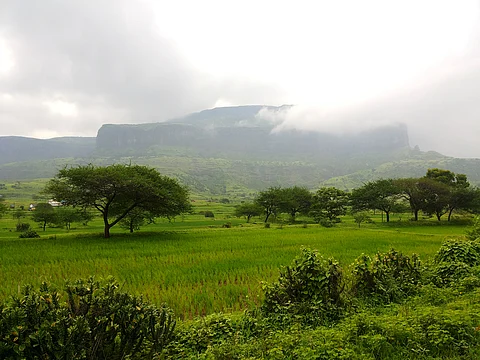
- Destinations
- Experiences
- Stay
- What's new
- Celebrating People
- Responsible Tourism
- CampaignsCampaigns
- Subscribe
- Buy Now

Perched amidst the dense, verdant folds of the Western Ghats about 20 kilometres from Nashik and 6 from Trimbakeshwar stands the decrepit Anjaneri Fort. It is an emblematic confluence of mythology, history and natural splendour. The site is revered as the birthplace of Lord Hanuman and thus fends off the limitation of being just as a trekking destination, attracting pilgrims seeking spiritual solace and serving as a testament to Maharashtra's rich heritage. Furthermore, the fort's strategic location in the Nashik-Trimbakeshwar mountain range also offers a certain panoramic views that one fails to witness otherwise, turning the place into a magnet for trekkers, historians and devotees alike.
The name Anjaneri comes from Anjani, the mother of Lord Hanuman. According to Hindu mythology, it is believed that Anjani performed intense penance on this hill which led to the birth of Hanuman, the embodiment of devotion and strength. The Bhavartha Ramayana by the saint-poet Eknath narrates Anjani's 7,000-year-long austerities atop Anjaneri Hill, culminating in Lord Shiva granting her the boon of Hanuman as her son.
However, beyond its mythological roots, Anjaneri Fort has witnessed several historical epochs. The fort's strategic importance was recognised during the Maratha era, with Chhatrapati Shivaji Maharaj fortifying it in the 17th century. Later, it served as the summer retreat for Raghunathrao Peshwa during his exile. During the British period, Christian missionaries from Saharanpur and Malegaon also frequented the site for religious services.
Situated atop an elevation of approximately 1,280 metres (4,264 ft) above sea level, Anjaneri Fort is immured in the gentle folds of the Western Ghats. The trek to the fort commences from Anjaneri village and offers a journey through lush landscapes, ancient caves, and stone-carved steps. The trail, amply suitable for beginners and seasoned trekkers alike, typically takes around 2-3 hours to ascend. Along the way, trekkers may come across attractions such as the birthplace of Hanuman, called the Anjani Mata Temple, and the Seeta Cave, a two-roomed cavern that can accommodate overnight stays for small groups.
That Anjaneri is at a stone's throw from both Nashik and Trimbakeshwar only adds to its appeal. Trimbakeshwar Temple, one of the twelve Jyotirlingas dedicated to Lord Shiva, is a significant pilgrimage site located nearby. In addition, the Brahmagiri Hills, considered the origin of the Godavari River, and the sacred Ramkund Ghat, associated with the Indian epic Ramayana, are both in close vicinity.
For those who are keen on food and culture, Nashik is a place that offers a gamut of experiences in that vein. The city is renowned for its vineyards that have turned it into a hub of wine tourism. Additionally, the Panchavati area, rich in temples and spiritual sites, gives you insights into the region's religious outlook.
In a moment of recognition of its ecological and historical significance, Anjaneri was declared a Conservation Reserve in 2017 under Section 36A of the Wildlife Protection Act, 1972. Spanning an area of about 5.69 square kilometres, this designation aims to preserve the region's biodiversity and cultural heritage.
The post-monsoon and winter months, from October to February, are the best times to visit Anjaneri Fort. The surrounding vegetation is in full bloom, and the weather is still comfortable during this season, making for a beautiful trekking experience. Trekkers should use caution during the monsoon season (June to September), due to slick trails and poor visibility, although the rains do transform the area into a verdant paradise.
Accessibility: Anjaneri is accessible via road from Nashik, with the base village located approximately 20 kilometres away. Public transport options include buses and taxis from Nashik Road railway station.
Accommodation: While there are limited facilities at the fort itself, nearby Trimbakeshwar and Nashik offer a range of lodging options to suit various budgets.
Preparation: Trekkers are advised to wear sturdy footwear, carry sufficient water, and be prepared for sudden weather changes, especially during the monsoon season.
In essence, Anjaneri Fort comes off as more than just a trekking destination; it is a journey through time, spirituality, and nature — immersed as much in mythology as in nature tourism. Whether you're a devotee tracing the footsteps of Lord Hanuman, a history enthusiast exploring Maratha legacies, or a nature lover seeking panoramic vistas, Anjaneri is a destination which has it all arranged in a single fold.
